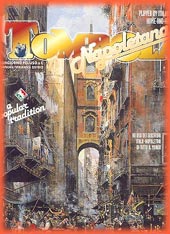|
 History History
From the post war to 1980 the Neapolitan game
of Bonifacciata, as most of the ancient rituals,
went through a progressive decline. The tombola
game was still played in the popular areas only,
mostly by old people. At that time , this kind
of game was considered not to be in agreement
with modern tastes; in fact, it was a poor ritual.
From that time on, there have been thousands original
tombolas, but the true tombola deepens its roots
in the noble culture of Naples. In the tombola
game everything is based on fortune and oral tradition.
A large board and the score cards, a wicker, cone-
shaped basket , also called "tombola" from which
the wooden numbers are extracted, then dried beans
to be used as number markers: these are the elements
of the game. Anyway, watch out! No one of the
ninety numbers is just a number: words, meanings,
dreams, daily life events are associated to that
specific number by popular imagination. 90 score
cards, 90 numbers, 90 cartoons, 90 Neapolitan
sentences and also 90 captions in English, the
language spoken by the Italian communities resident
in the USA, who are often the most jealous guardians
of popular tradition .
The game
The cost of a score card is fixed by the players.
Each player can buy as many cards as he like.
In turn, a player buys the large board - the equivalent
of six score cards- and becomes player and announcer
( that is the one who extracts the numbers, one
by one, and announces them aloud) in the same
time. The sum of money collected from the score
cards is the stakes which will be divided in five
different sums: 1st, 2nd, 3rd, 4th and 5th prize,
corresponding to the Double, Tern, Four numbers
row, Five numbers row and the Tombola ( all the
numbers of the board) So... enjoy yourselves and
Merry Christmas !
|




 History
History